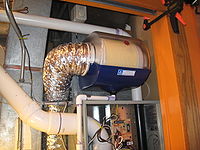Rotary Disc Furnaces
Rotary Disc Furnace is an industrial furnace through which the items being heated are transported on a rotating disk sole. Rotary Disc Furnace is a cylindrical industrial furnace that rotates about its longitudinal axis; it is designed for the heating of loose materials for physicochemical processing.
Main Classifications
Rotary furnaces are classified according to their heat-exchange method as having opposing or parallel flow of gases and materials and according to their method of energy transfer, as having direct, indirect (through the wall of the muffle), or combined heating of the material being processed. According to function, they are classified as rotary furnaces for roasting blends in the manufacture of alumina; for the production of cement clinker; for oxidizing, reduction, and chlorination roasting; for the calcination of aluminum hydroxide, coke, carbonates, sulfates, and other compounds; for dewatering materials; for the extraction of zinc and lead (rotary kilns); for the production of iron or alloys of nonferrous metals by their direct reduction from solid-phase ores (puddling furnaces); and for the roasting of refractory ore raw materials.
The main types of rotary furnace are those in which pulverized, solid, liquid, or gaseous fuel is burned directly in the working section of the furnace, and the heating gases flow toward the material to be processed. The metal drum, which is lined with refractory brick, is mounted at a slight angle to the horizontal on the supporting rollers. In some cases, the diameter of the drum varies along its length. The drum is rotated (1-2 rpm) by an electric motor through a reduction gear and an unshielded toothed transmission. The blend is loaded through a port at the head. Dry blends are loaded by mechanical feeders, but blends in the form of pulp are poured in or injected through nozzles. The fuel (10-30 percent of the mass of the charge) is injected through burners (nozzles) located in the heating cap. This is also the point from which the processed material is unloaded for cooling. The gases from the rotary furnace are cleaned of dust (sublimates). Various heat-exchange devices—rabbles, racks, mesh screens, and nozzles—are used to improve heat transfer. In a number of cases, the furnace lining is made in a special way (for example, cellular) for the same purpose. The basic dimensions of rotary furnaces vary widely: the length from 50 to 230 m, and the diameter from 3 to 7.5 m. The output of a rotary furnace may be as much as 150 tons per hour (processed product). There is a trend toward combining rotary furnaces with various heat-exchange equipment, thereby making it possible to increase the efficiency and economy of the furnaces while reducing their size.
Applications
Rotary disc furnaces are used in mass production to heat small metal billets before forging. The rotary furnace is similar in design to the ring furnace and differs only in the shape of the rotating sole and the working space. Articles are loaded and discharged through a single window, usually by hand. The outerdiameter of the rotary furnace is up to 5 m. The output is up to5 tons per hour. The furnace is heated by gas or liquid-fuel burners at the furnace wall.
Video
